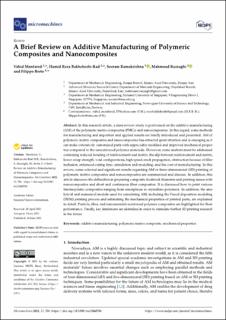| dc.description.abstract | In this research article, a mini-review study is performed on the additive manufacturing (AM) of the polymeric matrix composites (PMCs) and nanocomposites. In this regard, some methods for manufacturing and important and applied results are briefly introduced and presented. AM of polymeric matrix composites and nanocomposites has attracted great attention and is emerging as it can make extensively customized parts with appreciably modified and improved mechanical properties compared to the unreinforced polymer materials. However, some matters must be addressed containing reduced bonding of reinforcement and matrix, the slip between reinforcement and matrix, lower creep strength, void configurations, high-speed crack propagation, obstruction because of filler inclusion, enhanced curing time, simulation and modeling, and the cost of manufacturing. In this review, some selected and significant results regarding AM or three-dimensional (3D) printing of polymeric matrix composites and nanocomposites are summarized and discuss. In addition, this article discusses the difficulties in preparing composite feedstock filaments and printing issues with nanocomposites and short and continuous fiber composites. It is discussed how to print various thermoplastic composites ranging from amorphous to crystalline polymers. In addition, the analytical and numerical models used for simulating AM, including the Fused deposition modeling (FDM) printing process and estimating the mechanical properties of printed parts, are explained in detail. Particle, fiber, and nanomaterial-reinforced polymer composites are highlighted for their performance. Finally, key limitations are identified in order to stimulate further 3D printing research in the future. | en_US |

